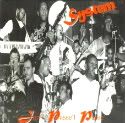 Waiting For Tom Hanks
Waiting For Tom Hanks
NewsHammer Exclusive No question the Large Hadron Collider scored a brilliant success with its first collisions at 7 TeV. Considering the extreme complexity of the detectors/ reactors this was a breathless performance. Soon after the 1 PM Geneva start, all four massive experiments were delivering data during the 3 hour window.
The first particle tracks and jets that were recorded surprised and delighted the physicists at CERN. At 7 TeV something new was going on that hadn't been seen before at any other collider, the signals of a New Physics. Though if you managed to sit through CERN's live webcast all day March 30, (video highlights: LHC First Physics) at least an interminable 27 km long, you still wouldn't have found out what that New Physics was or what CERN physicists were thinking. The only relevant comment I heard was that some muons were produced, and as they are decay products from heavier particles, some massive particles should have been produced, what CERN hopes for including the massive Higgs.
Great To Be Alive
With everyone so dazed and happy for the collider, by the time the CERN Press Conference started even the mostly 20-something journalists forgot to ask any new or relevant questions. It was one of those great cathartic moments where you're thrilled to have survived the biggest physics experiment ever when it's a hundred meters under your feet.
Confusing anyway to get focused on results with a loud echo for the first half-hour and more loud simultaneous French translation overlapping. Good thing CERN A/V wasn't running any important experiments. On camera four spokespersons and "two people waiting in Japan" weren't deterred. Another spokesperson for CERN PR coordinating the spokespersons and reporters while walking around the wireless mic kept tripping over the "two people" on the live video feed. "Two people waiting in Japan" who maybe had a comment? What were "two people" doing in Japan? What "two people"? The not just any "two people" turned out to be Sergio Bertolucci, CERN's Director of Research and Director General Rolf-Dieter Heuer, but anyway they were happy enough splitting a bottle of 1991 red collider wine, the year CERN started thinking about the LHC.
The only memorable quote of the day came from Dr Bertolucci:
"The most exciting thing is we are just mapping the unknown. And so the most striking things will be the unexpected things we might find there."

Fabiola? Wrong Control Room
Though we've heard variations on this theme from just about everyone. For the "unexpected things" well they're unexpected but at least we should be told just how much time we have before they arrive. CERN knows more or less but CERN won't say in so many words. Not even what the March 30 departure point was or where's the blasted finish line. Is today a sprint or the stage one of the marathon? What stages exactly? 7 TeV doesn't really cover it but it sounds great, another collider record. Get the camera Fabiola!
Listening very closely that day some of us were sort of warned. Piecing it together from the friendly banter the LHC was still taking its first "baby" steps. Mama and Papa CERN were very proud. If there was a buzz word through that exhausting day, it was "baby" and double that for "new babies" from our excited Italian hostess, who was doing nearly all the talking for everybody in her webcast from control room to control room while two guys were chatting in a loud French voiceover, like at the back of a church. They had some interesting things to say if you could hear them. Thanks CERN A/V, a division of CERN PR, leaving us hankering for Tom Hanks in the final analysis.
Instead of a nice clean start, say 2 minutes of CERN's objectives for the day or a Press Release on that: how many bunches of protons, how many protons per bunch for this first 7 TeV experiment -- a lot of happy and excited people at CERN were telling us over and over again how happy they were for and hours and hours. Sure we're glad they're all happy. But being so very happy about all the ''new babies" the collider was having, our hostess and her physicists forgot what millions of people out there wanted to know. Was she going to bring them coffee?
Even 40 Live Status LHC Pages were no help with how many bunches were loaded into the collider that day: The CERN variation on Russian Roulette.
Bits of what we needed to know did come out in gurgles. ATLAS was having fewer "babies", only about 30 per second, while CMS was having 100 "babies" per second, and LHCb went from 50 to 60 "new babies", but we never did find out if ALICE got knocked-up down the rabbit hole until we saw the "baby" scan and hers were certainly hairier than any other "new babies", so Wow.

ALICE Hairy Baby Scan
The "babies" were collision events of course, 2 protons making one collision "baby", but the mother of all colliders obviously wasn't making "babies" the way she should. Where were all the other "babies"? Once upon a time CERN was forecasting 1 million collisions per second per experiment. Later on at the mighty ATLAS we got the new ultimate forecast: 40 million "babies" per second in each detector or times 4 making 160 million per second overall.

Squeezing More Babies
Evidently for now something was wrong. Not enough squeezing going on, or a low proton count. Both as it turned out, but you had to beam down via the Internet and watch the naked collider in action. The first clue was March 29, NewsHammer "CERN Fires The Collider" when only 2 bunches per beam made it into the collider round. Then bright and early March 30 there were 2 aborted ramps to get stable beams and with millions of people getting bored CERN tried square one. With the "baby" machine feeling testy, the absolute minimum 1 bunch per beam was knocked in instead of 2 or the nominal 2808 bunches per beam we were told to expect for years and years.

10 Billion Protons Instead of 561,600 Billion Protons
Then how many protons? The maximum per bunch is 100 billion according to CERN. Nobody said how many protons before, during or since March 30, but one of the two French guys in the background voiceover did mention "5 milliards de protons" or 5 billion, or 1/20 the nominal number of protons per bunch. So at most there were 10 billion protons that could have collided, or in overall terms the very rock bottom minimum or the lowest possible luminosity next to zero. The maximum intensity would have been 2 x 2808 x 100 billion for a very large number of protons circulating eventually or 561,600 billion. Versus 10 billion protons March 30, meaning the LHC achieved 1/56,160 of its potential in protons. Far less than that when it comes to LHC luminosity or the ultimate shootout at CERN's OK Corral.
During the webcast we did catch 2 other related facts. At 10 billion protons in the collider, maximum collisions in any one detector would be 11,000 per second where at CMS with the most "babies" there were 100 per second. ATLAS was aiming for 40 million collisions per second in any detector, but not today.

CMS On Top
CMS with the best score achieved 100/40,000,000 or 1/400,000 of what it can do at 7 TeV. Or at the per second OK Corral Rehearsal 200 bullets smashed into each other vs 80 million that will smash one of these days.
If all goes well late next year we might see maximum luminosity at 7 TeV or 400,000 times more collisions per second. In 2013 the ultimate proton fireball at 14 TeV will be over (no typo) 100 billion times the core temperature of our sun or ~ 10^16 °C.
Step 4: "Don't panic." Good advice from an LHC operating manual.
Hot enough for ya? will be something to brag about if there's anyone left at CERN.

ATLAS Trying For Better Days
So the big event March 30 was a very small physics experiment, though with some risk to the LHC machine. Because of the way CERN handled it and the media reported it, there's a general sigh of relief. We're still here, the LHC is safe. Nothing more to worry about after the Barnum and Bailey Collider Test.
Nothing wrong with going for the smallest possible test at 7 TeV. The smart and prudent way to go, except when you don't disclose the facts clearly and let people imagine they're getting the full Big Bang for their buck. Echoes of "There's one born every minute."

LHCb: What You Say?
Belatedly offering soundbites to the media on increasing collisions to 300 per second and a stab at luminosity, again after the brouhaha of March 30, is more you-knew-all-along sleight of hand through the back door for millions of empty chairs who won't complain. Making lame excuses before the collisions like the LHC would be colliding beams together over the Atlantic, in case of PR failure, was rather embarrassing, though a genuine attempt at some false modesty.
Canceling the Tom Hanks Show at the collider was the biggest CERN event. It finally dawned on CERN that the most important physics experiment since Trinity should be treated seriously. The live interactive video/data player for the webcast was first rate and another positive step. But being hustled into CERN's Big Top for a handful of firecrackers like this is it, The Greatest Show on Earth, is another sad comment on how easy it is to fool people.
You can make allowances for any live event, that the excitement overtakes the action and the facts. But CERN has had years to get the facts across and a week since March 30 for revisiting unfortunate false impressions. The postmortem CERN Press Release "Yes we did it" makes no corrections.
Of course there are no bragging rights if CERN simply stated in advance and during the March 30 demonstration that the 7 TeV test collisions were slated for about 1/400,000 of design efficiency. Then of course nothing of LHC safety would be proved either, except that the LHC is apparently safe to operate at an extremely tiny fraction of its potential. Now that the public is satisfied with safety CERN can go to the LHC maximum. Not right away, as the machine is unreliable. Failures since start-up including this week are common. Luminosity consequently has to be coaxed up in stages or there will be no more "babies"and no more collider.
Go slow is commendable to save the collider from another accident. But why not tell us? It was no secret inside CERN, just outside.
The biggest safety issue has always been the LHC's New Physics. Now apparent safety (of small numbers) of 7 TeV collisions will be taken as a proof of safety for what is to come.
Actual physics results even from March 30 may never be fully known. Dangerous sorts of Collider Objects might have been produced and might have gone undetected during the 3 hour run of March 30 of about 1/2 million proton collisions recorded. What will happen in 2011 in a proton fireball of 40 million collisions per second? When the truth is known, you can fly.

CERN's Smoking Gun
CERN had already predetermined that First Physics at 7 TeV would be 1 proton bunch per beam, 1 x 1 for the first three days of collisions, then a week of tests on multi-bunches, then a jump to 4 x 4 or 4 bunches per beam colliding for another 2 days. Then a bigger jump to 12 x 12 collisions for 2 more days. Then who knows? Though CERN hasn't been able to achieve these results due to ongoing machine failures.
Down the road: "BEAM PARAMETERS AND MACHINE PERFORMANCE TO BE REACHED IN 2010"*.
What we can expect now is less machine risk as proton bunches are gradually maximized in stages. It will take until the end of this year to reach about 800 bunches per beam out of 2808, another lucky fact blown out of CERN's windy webcast. Luminosity will still continue climbing next year to the maximum.
The obscure but essential CERN document (above) "Pilot physics run at 3.5 TeV"* should have been released to the public before March 30 or summed up in a CERN Press Release. Just a reminder to CERN that Press Releases are for the Press and provide the Press with tools, not more hot air to analyze. This short document would have made CERN's intentions clear on going slow (adding the rationale: the minimizing of machine failures and damage) and that would have pre-empted all the phony suspense of March 30. We could have got some more sleep instead.
The Future At 7 TeV
So we're not much further ahead in knowing what to expect from the LHC. The preliminary data and continuing collisions will give physicists some ideas, but data analysis isn't that easy. It could take months to see some New Physics papers on what happened.
Even so physicists will be reluctant to draw conclusions from a few collision events, which is why they want to see 40 million per second.
The funny thing is, because of the enormous amount of data these collisions produce, CERN's entire computing power can only record 2,000 events per second. So CERN will filter all data, discarding nearly all of it, hoping their filters will capture only the significant events, whatever they are.
For now and since CERN decided to blast us with Collider PR 10 years ago, we're in another prolonged state of suspense. When is the axe going to fall? Certainly it looks like there is a better chance for safety in terms of shutting down before hazardous events arrive, if data analysis can determine the next threshold where New Physics might spin out of control. Though there are no guarantees that we'll have any bumpy warnings. Just ask ALICE when she's 10 feet tall.

LHC News: Doomsday Postponed
As to the future, the only real news out of the Press Conference was delivered by Steve Meyers, Director of Accelerators and Technology who talked about some long term goals and difficulties, announcing the next planned shutdown in Autumn 2011. After a year of upgrades to safety systems for another $235 Million (not mentioned) the LHC should be ready to start 14 TeV collisions in 2012, though giant bending magnets will still be difficult to retrain, some 1/3 of about 1,800 (not mentioned) needing 25 to 30 ramps and quenches. The much fabled LHC might have to settle for 13 TeV.
*Note to CERN Techies: Put dates on all your documents. If Plan "A" is PR Mystification, your Plan "B" Common Timeline Confusion will mystify everyone else at CERN who needs to sift through a mountain of links to a mountain chain of documents that might save your life.
This is Part 7 of a series on machine safety and potential risks of expected Collider Objects like mBH at the LHC when the collider jumps to very high energies starting March 30, 2010. "Doomsday Report: New Physics At The LHC" will appear in The Science of Conundrums.
NewsHammer Part 1: Large Hadron Collider Waiting For Doomsday
NewsHammer Part 2: Fantastic LHC Energies May Be Higher Than Expected
NewsHammer Part 3: Higgs Discovered At The Large Hadron Collider / More Delays
NewsHammer Part 4: Scrubbing CMS Data At The LHC
NewsHammer Part 5: LHC Lords Of The Ring
NewsHammer Part 6: CERN Fires The Collider
--Alan Gillis

















0 comments
Post a Comment